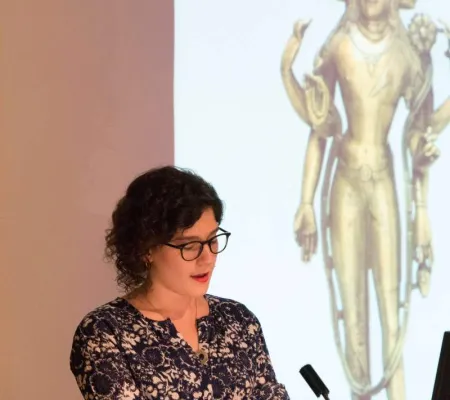The Department of Art and Art History is excited to host the sixth annual Undergraduate Art History Research Symposium as part of The University of Texas at Austin's Undergraduate Research Week 2018.
Program
Alyssa Miller
Through the Lens of a Cope: A Study of Evolving Values
In this presentation, Miller will discuss how the Blanton Cope reflects the changing notions of what constitutes art. Our society’s most privileged and cherished cultural objects are showcased in museums, but what objects are featured depends on the values of contemporary curatorship. Painting and sculpture are displayed with far more frequency than textiles and other examples of the decorative arts. With consideration of Baxandall’s period eye, we come to understand that these objects that are largely undervalued today were given preeminent status in their own time. Through the perspective of the Blanton Cope the values of Renaissance and today’s society will be analyzed and reflected upon.
Scilla Myers
Art in the Street: Carlos Cruz Diez's Crosswalks of Additive Color
Myers’ research focuses on the painted crosswalks of the Venezuelan kinetic artist Carlos Cruz-Diez. Since their initial creation in 1975 the crosswalks have been featured in cities around the world such as, São Paolo, Houston, and Liverpool. Despite the fact that Cruz-Diez has designed them for over forty years, the crosswalks have been largely overlooked in scholarship about his work. Using the philosophy Cruz-Diez has developed throughout his career, Myers investigates how the crosswalks fit into his oeuvre, arguing that the crosswalks represent the culmination of his desire for a participatory artwork open to all people. Therefore, they should be recognized as a significant series in his body of work.
Mackenzie Nissen
An Origin of Discomfort: Gustave Courbet and the Propriety of Display
There is a certain discomfort in not being able to categorize an image of a nude female body into one of two binary categories: the obscene and pornographic or the appropriate and canonical. So what is a viewer to do when confronted with a pornographic image–that of a cropped view between a woman’s spread legs–in the context of a work of fine art? And further, what is a curator to do when incorporating the image into a public museum’s galleries? This talk will discuss how the current curatorial choices surrounding Gustave Courbet’s l’Origine du Monde at the Musée d’Orsay in Paris fits into the painting’s historical framework of display and how a modern viewer might be able to understand the issues they may face when confronted with a female nude that does not quite fit into the typical binary.
Nick Purgett
Weaving Sanctity in Bone: Influences and Interpretation of a 13th century Bone Ivory Reliquary
Categorically, ivories represent a corpus of exquisite objects, and much attention has been given to these items produced from the late 13th to the early 15th century, particularly in France. However, considerably less attention has been given to ivories produced around the turn of the 13th century in Germany, in this case, Cologne. In examining a tower made from bone ivory during this difficult epoch, one realizes why these objects remain so understudied. They subvert and complicate our traditional notions of development of the Gothic style, alluding to international connections to the Byzantine and Cologne's civic identity more than a slavish imitation of the latest and greatest in French Gothic architecture. This talk examines these international connections while also interpreting a previously understudied piece of iconography on the vessel, arguing that this relic once held a piece of sacred tapestry.
Sofia Yazpik
The Eyes of Dionysus: Eros and Hubris on an Amphora by Exekias in the British Museum
Yazpik’s research examines a black-figure amphora by Exekias, the esteemed Athenian potter-painter, that is dated to 540-530 BCE. The amphora illustrates Achilles slaying Penthesilea, the Amazon, in battle on one side, and Dionysus and Oinopion, his son, on the other. The purpose of Yazpik’s research is to identify the relationship between both sides of the amphora, and analyze the reasons as to why Exekias might have placed these characters on the same vase. This presentation will focus on the importance of Achilles’ role as a “hero” in order to better understand his relationship with Penthesilea, and in turn, identify the purpose of Dionysus’ presence. Yazpik argues that Exekias utilizes Achilles’ faults as a hero to promote a warning to the ancient viewer, and furthermore, Dionysus emphasizes such faults so that humanity could acknowledge the boundaries and limitations they face and cannot surpass.
Grace Zhang
The Revolution Will Not be Televised: Exploring Societal Trauma Through Video Art
Born of the tumultuous 60’s and 70’s amid an environment of unprecedented modernity and globalization, video art utilized the new standard visual language - the moving image - as an effective tool for both remembrance and confrontation. Emancipated by artists from its broadcast counterpart, video not only examined societal shortcomings but also confronted societal traumas obfuscated by new cultures of excess. Today, artist Phil Collins contemporaneously echoes these themes, exploring global conflicts and their memories as well as legacies through different modes of audience reception in video. With the tendency of the moving image and its popular iteration of broadcast television to numb and desensitize, Collins and his predecessors in video seek to put into practice Gil Scott Heron’s proclamation: you will not be able to plug in, turn on and drop out…because the revolution will not be televised."


